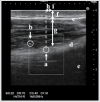Establishing a new appropriate intramuscular injection site in the deltoid muscle
- PMID: 28604191
- PMCID: PMC5612213
- DOI: 10.1080/21645515.2017.1334747
Establishing a new appropriate intramuscular injection site in the deltoid muscle
Abstract
It is becoming increasingly important for clinicians to identify a safer intramuscular (IM) injection site in the deltoid muscle because of possible complications following the vaccine administration of IM injections. We herein examined 4 original IM sites located on the perpendicular line through the mid-acromion to establish a safer IM injection site. Thirty healthy volunteers participated in this study and the distances from our 4 IM sites to some anatomical landmarks on their left arms were measured. Ultrasonography (US) was also performed to measure the thickness of the deltoid muscle and identify the posterior circumflex humeral artery (PCHA) along the course of the axillary nerve. Subcutaneous thickness was measured using 2 methods: measuring the skin thickness with caliper after pinching the skin, and with US. The results obtained revealed that the intersection between the anteroposterior axillary line (the line between the upper end of the anterior axillary line and the upper end of the posterior axillary line) and the perpendicular line from the mid-acromion was the most appropriate site for IM injections because it was distant from the axillary nerve, PCHA, and subdeltoid/subacromial brusa. At this site, depth of needle insertions was 5 mm greater than the subcutaneous thickness at a 90° angle, which was sufficient to penetrate subcutaneous tissue in both sexes. Subcutaneous thickness can be assessed with almost the same accuracy by US or measuring with calipers after pinching the skin. The results of the present study support the improved vaccine practice for safer IM injections.
Keywords: Safe site for injection; axillary nerve; best practice; deltoid muscle; needle depth; nursing practice.
Figures





Similar articles
-
An evidence based protocol for the prevention of upper arm injury related to vaccine administration (UAIRVA).Hum Vaccin. 2011 Aug;7(8):845-8. doi: 10.4161/hv.7.8.16271. Epub 2011 Aug 1. Hum Vaccin. 2011. PMID: 21832883
-
Skin-to-deltoid-muscle distance at three recommended sites for intramuscular vaccination in a population with obesity: an observational study.N Z Med J. 2023 Apr 14;136(1573):67-76. doi: 10.26635/6965.5915. N Z Med J. 2023. PMID: 37054456
-
Randomized trial using ultrasound to assess intramuscular vaccination at a 60° or 90° needle angle.Vaccine. 2013 May 28;31(23):2647-52. doi: 10.1016/j.vaccine.2013.03.037. Epub 2013 Apr 6. Vaccine. 2013. PMID: 23566948 Clinical Trial.
-
Best vaccination practice and medically attended injection site events following deltoid intramuscular injection.Hum Vaccin Immunother. 2015;11(5):1184-91. doi: 10.1080/21645515.2015.1017694. Hum Vaccin Immunother. 2015. PMID: 25868476 Free PMC article. Review.
-
Vaccine injection technique and reactogenicity--evidence for practice.Vaccine. 2008 Nov 25;26(50):6299-304. doi: 10.1016/j.vaccine.2008.08.052. Epub 2008 Sep 17. Vaccine. 2008. PMID: 18804137 Review.
Cited by
-
Fibrous myopathy induced by intramuscular injections of cyclizine.BMJ Case Rep. 2020 May 11;13(5):e233544. doi: 10.1136/bcr-2019-233544. BMJ Case Rep. 2020. PMID: 32398247 Free PMC article.
-
SIRVA (Shoulder Injury Related to Vaccine Administration) following mRNA COVID-19 Vaccination: Case discussion and literature review.Vaccine. 2022 Apr 20;40(18):2546-2550. doi: 10.1016/j.vaccine.2022.03.037. Epub 2022 Mar 21. Vaccine. 2022. PMID: 35339304 Free PMC article. Review.
-
COVID-19 vaccination and the skin to deltoid MUSCLE distance in adults with diabetes.Vaccine X. 2023 Apr;13:100248. doi: 10.1016/j.jvacx.2022.100248. Epub 2022 Dec 15. Vaccine X. 2023. PMID: 36536872 Free PMC article.
-
Adverse events after BNT162b2 mRNA COVID-19 vaccination in health care workers and medical students in Japan.J Infect Chemother. 2022 Aug;28(8):1220-1224. doi: 10.1016/j.jiac.2022.05.002. Epub 2022 May 11. J Infect Chemother. 2022. PMID: 35577684 Free PMC article.
-
Moderate Heat-Assisted Gene Electrotransfer for Cutaneous Delivery of a DNA Vaccine Against Hepatitis B Virus.Hum Gene Ther. 2021 Nov;32(21-22):1360-1369. doi: 10.1089/hum.2021.037. Epub 2021 Jun 9. Hum Gene Ther. 2021. PMID: 33926214 Free PMC article.
References
-
- Treas LS, Wilkinson JM. Basic nursing: concepts, skills & reasoning. Philadelphia PA: F.A.Davis Company; 2014
-
- Malkin B. Are techniques used for intramuscular injection based on research evidence? Nurs Times 2008; 104:48-51; PMID:19165987 - PubMed
-
- Fujimoto E. The problem of using deltoid muscle for intramuscular injection. Aino J 2007; 6:49-53
-
- National Center for Immunization and Respiratory Diseases General recommendations on immunization— recommendations of the advisory committee on immunization practices (ACIP). MMWR Recomm Rep 2011; 60(2):1-64 - PubMed
-
- Beyea SC, Nicoll LH. Administration of medications via the intramuscular route: an integrative review of the literature and research-based protocol for the procedure. Appl Nurs Res 1995; 8(1):23-33; PMID:7695353; https://doi.org/10.1016/S0897-1897(95)80279-7 - DOI - PubMed
Publication types
MeSH terms
Substances
LinkOut - more resources
Full Text Sources
Other Literature Sources
Medical
